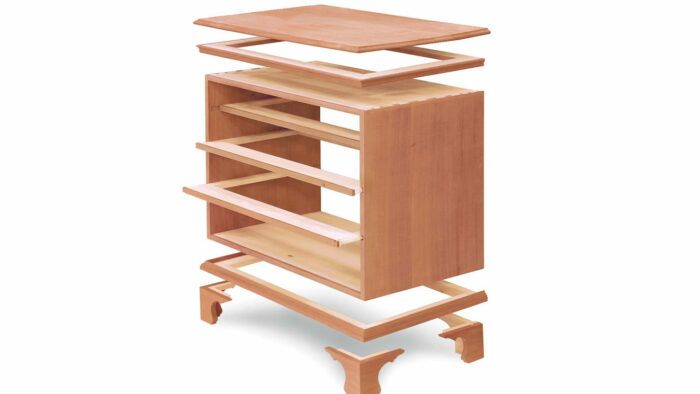Anatomy of a chest of drawers
Start with a dovetailed box, then choose among options for drawers, moldings, and base
Synopsis: Will Neptune breaks down the design of a chest of drawers, showing various methods so that someone at almost any skill level can successfully complete a chest to taste. His instructions for constructing a carcase, building drawer dividers, drawer fronts, moldings, bases, and feet, are essential for building a chest of drawers in any style—from 18th century to modern designs. He also offers efficiency tips along the way that will reduce frustration in later steps.
From Fine Woodworking #163
Case furniture based on a dovetailed box is found in a wide range of styles and periods. While the details vary, many pieces can be built using similar construction solutions. When I build a case, I work from a firm set of ideas—both traditional and modern—that I’ve found to be reliable and efficient.
The techniques required to make a chest of drawers are mostly common knowledge: dovetails, dadoes, miters, mortises, and tenons. The complex appearance is the result of a straightforward sequence of simple steps. At its most basic level, a chest of drawers is a stack of separate assemblies. However, based on moldings (or lack thereof), leg treatments, drawer styles, proportions and materials, a wide variety of case pieces is possible. This article describes a basic, proven construction approach. The execution is up to you.
When preparing your primary stock for the sides of the case, put aside strips to be used later to edge the top and bottom case panels as well as the drawer dividers. Using wood from the same board will give a uniform look to the case.
A chest of drawers begins with four panels: top, bottom, and two sides. The strips of primary wood that edge the top and bottom can be glued onto the secondary-wood panels after rough-milling. Match the grain direction of all parts during glue-up so they can be finish-milled as one piece.
The case is joined with half-blind dovetails, so lay them out for strength, not appearance. You may want extra tails near the edges, especially the front, to resist loads that could pop the front shoulder.
Another trick makes the joinery for the back a little easier. Run the rabbets for the back boards all the way up the sides without stopping. Then rip the top and bottom panels flush with this rabbet; the back boards will extend all the way up to the top and bottom of the case but be hidden by the true top, which goes on later.
For the full article, download the PDF below.
 |
How to engineer a chest of drawersHow to build a case that will stay square and stable through the seasons |
 |
Illustrated guide to drawersThe ideal drawer? That depends. Here’s how to choose. |
 |
Build a Shaker chest of drawersYears of experience mending antiques led to the methods Tom McLaughlin used on this Shaker chest of drawers to ensure that it will live to be an antique someday, too. |
Fine Woodworking Recommended Products

Compass

Stanley Powerlock 16-ft. tape measure

Starrett 12-in. combination square





















Log in or create an account to post a comment.
Sign up Log in